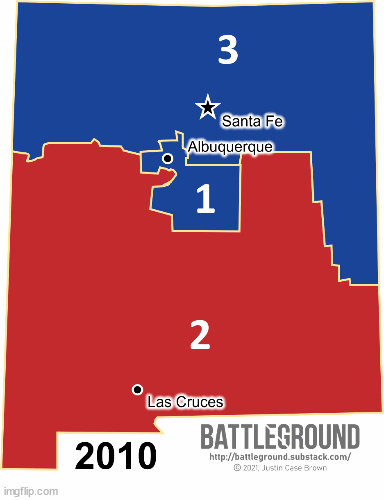New Mexico: The Citizens' "Gerrymander"
Moves to increase Latine representation are seen by some as gerrymandering.
Topline Takeaways
New Mexico’s new congressional districts were borne out of a community involved redistricting process. The state’s Citizen Redistricting Commission developed proposals through negotiations with advocacy groups across the state.
After receiving the commission’s recommendations, Democrats in the state legislature made adjustments that made the map slightly more favorable to their party.
Republicans across the country are decrying the new districts as a partisan gerrymander but this overlooks the goal of creating at least one majority-Latine district. (NM has the highest percentage Latine population in America.)
Who’s In Control?
New Mexico’s redistricting process is controlled by the state legislature and requires gubernatorial approval before being adopted. The state also has a Citizen Redistricting Committee that recommends map proposals to the legislature. The legislature is in no way bound to enact the recommendations from the independent commission. Even though Democrats have complete control over redistricting as they control all three branches of state government, the adopted plan is essentially a proposal from the independent commission with some slight modifications from state Democrats.
New District Breakdown
New Mexico’s three new congressional districts meet just outside of the state’s largest city: Albuquerque. The city and its surrounding suburbs hold just over 1 million residents and each of the state’s districts must hold roughly 700,000 residents each to be of equal population. There are more than enough people in and around the city for Albuquerque to anchor its own congressional district. Republicans across the country have railed against the map as a partisan gerrymander due to the way it severs small portions of the Albuquerque metro area and instead stretches way out into the rural center of the state. What these critics fail to understand is that the decision to take a couple of communities out of the Albuquerque-anchored NM-1 was a decision advocated for by citizens for stronger Latine representation.
The clearest example of this is South Valley, a census-designated place that sits at the southern end of the Albuquerque metropolitan area. The Citizen Redistricting Commission explicitly explains the reasoning behind putting South Valley into NM-2 rather than NM-1
Even though South Valley and the Mesilla Valley are 200 miles apart, grouping these communities into NM-2 helps create a majority-Latine district, the only one in the state. (The other two districts are majority nonwhite but not majority-Latine.) This was especially important to residents as nearly half of all New Mexicans identify as Hispanic or Latine.
Unfortunately, later changes to the map by Democrats undercut the argument that the map’s odd boundaries are for the sake of increased Latine representation. Those slight modifications from the commission’s proposal helped tilt the new NM-2 slightly in favor of Democrats, giving credence to cries of partisan gerrymandering. (The commission’s proposal would have made NM-2 a true swing district, leaning only a single point toward Democrats.)




